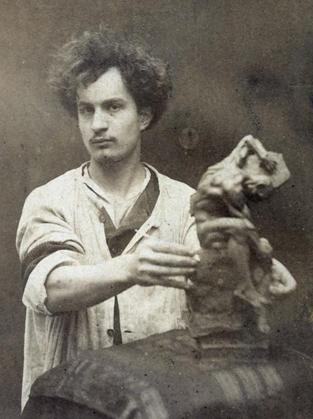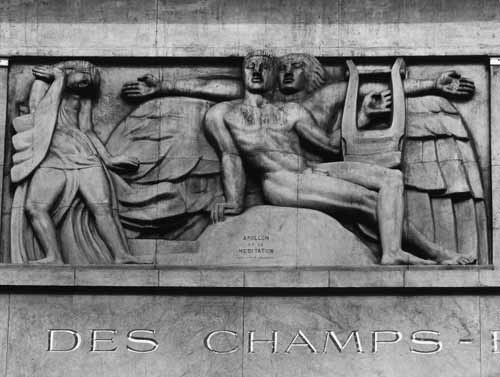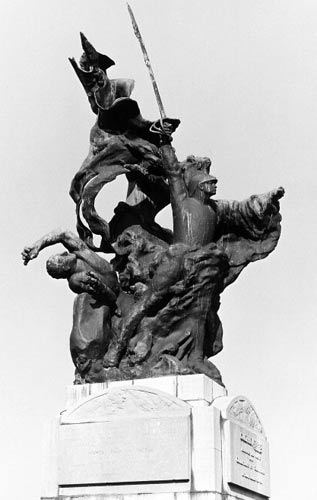Emile Bourdelle

Emile Antoine Bourdelle was born in Montauban on 30 October 1861 to Antoine Bourdelle, a cabinet-maker who would introduce him to working with materials at the age of thirteen, and a mother who would teach him the essential values of a simple and rustic lifestyle. The fauna statuette he created that adorns a mill caught the attention of two local personalities, Hyppolite Lacaze and Emile Pouvillon, who encouraged him to enrol in the course offered by the municipal art school then directed by Achille Bouis. In 1876, Bourdelle was granted a scholarship to study at the Beaux-Arts de Toulouse. He used the solitude of his years as a student to complete his first masterpieces: Les Trois Têtes d'Enfants, the portrait of Achille Bouis and the portrait of Emile Pouvillon. In 1884 he went to Paris, where he began working at the Falguière workshop at the Ecole des Beaux-Arts. In 1884, he set himself up in a modest workshop in Impasse du Maine. In 1885, the young sculptor sent the La Première Victoire d'Hannibal to the Salon des Artistes Français, for which he received a merit. Exhausted, the sculptor was hospitalised. After a period of convalescence in Montauban, Bourdelle, convinced of the futility of the teaching and prize he had been given, distanced himself from the Ecole before leaving in 1886, the year he created L'Amour Agonise.
In 1888, a recurring theme would appear in Bourdelle's work: the portrait of Beethoven. In 1891, the sculptor would exhibit his work at the exhibition of the Société Nationale des Beaux-Arts for the first time. Bourdelle would again find new masters, who rather would be companions for him: he visited the workshop of Dalou, in Impasse du Maine, and in 1893 would form a collaboration with Rodin at the Falguière workshop. In 1897, the city of Montauban commissioned him to create the Monument to the Defenders of 1870. In 1900, he founded with Rodin the Institut Rodin, a free school for training in sculpture. During this period he created among his growing list of requests Les Nuées, a relief to be placed on the stage of the Musée Grévin. Works such as Le Ménage Bourdelle, L'Ouragan and M. et Mme Bourdelle Par Temps d'Orage, bore witness to a particularly tumultuous domestic life. His circle of close friends consisted of Félicien Champsaur, Marie Bermond, Jean Moréas, Elie Faure and even Jules Dalou. 1902 was the year the artist became known to the wider public, when he inaugurated the monument to the dead of Montauban. In 1905, Bourdelle held his first exhibition at the gallery of the foundry owner Hébrard. That year, he exhibited a Pallas in marble at the Société Nationale des Beaux-Arts. He made a number of overseas trips which bore witness to the interest he had created outside his own country. In 1907, he visited Berlin and Geneva, while in 1908 he visited Poland as a member of a panel of judges for the erection of a monument to Chopin.
It was at this time that the sculptor began to mature, and he and Rodin went their separate ways. He began to teach in 1909, giving courses at the Académie de la Grande Chaumière, where his understudies included Giacometti and Germaine Richier. These years were also the most intense for the master in terms of production: in one night, he completed models for the façade of the Théâtre des Champs-Elysées while at the same time working on the Dying Centaur, the Statue de Carpeaux and the monument to Auguste Quercy. In 1910, Bourdel completed his masterpiece: the Archer Heracles. This work was displayed at the Société Nationale des Beaux Arts, with the Bust de Rodin. A year later, Bourdelle unveiled the plaster cast of Pénélope and completed the maquette of the monument to Mickiewicz. In 1913, the site of the Théâtre des Champs-Elysées was completed. With its low-reliefs and friezes of subjects inspired by mythology, Bourdelle realised his ideal of structural art, an art form in which decor is subject to the laws of architecture. His research into the monumental continued with the order for the monument to Alvear, the most important he had ever received, followed in 1919 by those for the monuments of Montceau-les-Mines and Vierge for the offering to the hill of Niederbrück. Prior to his death, Bourdelle would create numerous other models but would not have time to complete these monuments (monuments to Daumier, Marshall Foch, etc.).
1914 was notable for success at the Venice Biennial and the presentation of the Dying Centaur to the Société Nationale des Beaux-Arts. His success was soon confirmed: in 1919, the sculptor was appointed Officer of the Legion of Honour. His circle of acquaintances also began to feature new faces, such as André Suarès, Anatole France, Krishnamurti and Henri Bergson.
While continuing to exhibit at the Société Nationale des Beaux-Arts, in 1920 Bourdelle established the Tuileries exhibition with Besnard and Perret. He exhibited the Naissance d'Aphrodite at the Tuileries exhibition, then at the International Decorative Arts Exhibition (Sapho, Masque de Bourdelle) in 1925, in Japan and the United States. The bronze statue of the Dying Centaur was shown at the Tuileries exhibition. The last years of Bourdelle's life were marked by his experimentation with polychromy. In 1926, he made his first polychrome sculpture models, the Reine de Saba and the Jeune Fille de la Roche-Posay. While La France was put on display at the Tuileries exhibition, the monument to Alvear was inaugurated in Buenos Aires. A year before his death, Bourdelle was triumphant: the first Bourdelle retrospective was proposed for the inauguration of the Palais des Beaux-Arts of Brussels (141 sculptures and 78 paintings and drawings). On 28 April 1929, the monument to Mickiewicz was inaugurated in the Place de l'Alma. Bourdelle died in Vésinet on October 1 at the home of his friend, the foundry owner Rudier.
Emile Bourdelle's talent has helped perpetuate numerous memorial sites: - in Montauban, Bourdelle fashioned the Monument aux Combattants et Défenseurs du Tarn-et-Garonne 1870-1871 and the Monument à la Mémoire des Combattants de 1914-1918; - the Victoire du Droit, at the Assemblée Nationale ; - the Archer Heracles at the Temple du Sport in Toulouse; - the Monument de la Pointe de Grave, to commemorate the entry of the United States in World War I in 1917 ; - the Monument aux Morts at the school of Saint-Cyr (Coëtquidan), a bronze initially erected in 1935 in Algiers; - the mould that was initially used in the creation of the bronze of the Monument des Forces Françaises Libres; - the Figures Hurlantes of the Monument de Capoulet-Junac (Ariège) ; - the stele of Trôo (Eure-et-Loir) ; - the monument of Montceau-les-Mines (Saône-et-Loire), one of the faces of which was named "Le Retour du Soldat".

Fresque du théâtre des Champs Elysées. 1913. Source : www.artandarchitecture.org.uk

La défense du drapeau. Pont Vieux à Montauban.
Source : www.artandarchitecture.org.uk

